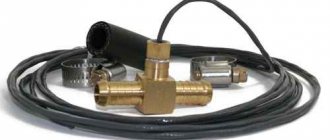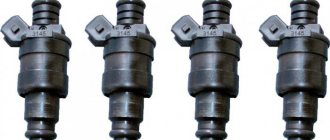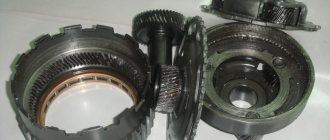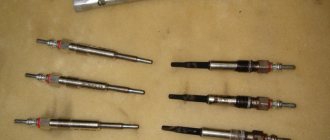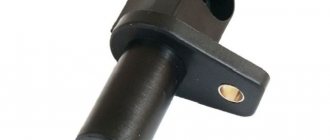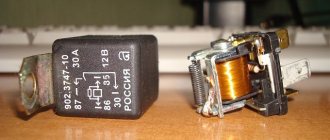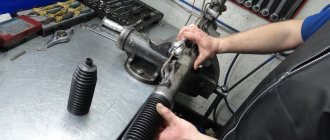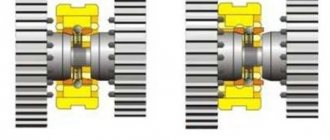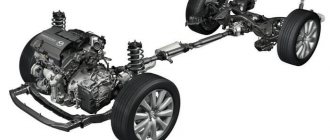Tie rod ends: why your safety depends on them
Failed tie rod ends not only reduce the ride comfort of your vehicle, but can also pose a real safety hazard. Let's take a look together at what surprises one of the simplest structures in a car can present, why, if a malfunction is identified, it is better to entrust its repair to professionals, how to identify a breakdown, and is it worth immediately changing the steering tip at the first sign of damage?
If we exaggerate, we can say that at least one axis of the car must be steerable so that the car can change direction, that is, steer. And since the car’s wheels also have springs, transferring force to the steering mechanism is not an entirely simple task, one of the most important links for solving which was such an element as the tie rod end:
Without this small but important element of traction, nothing will work.
REPLACING THE STEERING END BOOT
It often happens that the steering tips themselves are in good condition, but a visual inspection reveals a rupture of the boot. If you leave it in this condition, it will soon become unusable and will have to be replaced.
The sequence of work when replacing the steering tip boot is the same as when completely
the only difference is that after pressing it out of the steering knuckle of the strut, you need to remove the ring securing the boot and replace the damaged one with a new one.
Before this, it is recommended to remove the remaining old grease and fill the new boot with lithol. It is important not to overdo it when doing this, otherwise the new boot may tear from excess lubricant.
Diagnostics of the steering part of a car is the key to safe driving not only for the driver and his passengers, but also for road users. Safety and comfort while driving depend on the serviceability of all elements of this unit, including the steering rod with ends. In this article, I will tell you about these important elements, and also look at how to properly replace tie rod ends and tie rod replacement.
Steering rod is an element related to steering, the main task of which is to prevent the car from sliding when turning. The correct operation of this element contributes to the correct rotation of the drive wheels. Consists of middle, right and left rods and levers for the left and right wheels. Depending on the car model and type of construction, there are many types of traction.
The ends are the final elements that go from the steering rod to the car wheel. They have another name - hinges. These parts are part of the car's steering and an integral part in the operation of steering rods. The hinges look like hemispherical fingers. The main reason for failure is their fragility. They cannot be partially repaired, since the replacement is carried out entirely. The tip consists of the following parts: a body with an axis, a threaded pin, a Teflon gasket along which the finger moves, a protective housing (designed to protect the tip from deformation and shock), a plastic cover to protect the steering tip and housing, a silicone ring for protective cover fastenings, spring and nut.
One of the main guarantees of normal operation and long-term operation of all components and parts of the car is timely and correct diagnostics.
To ensure that the steering rod is not replaced so often, you need to monitor some parameters. The tips should move along the axis of the fingers by no more than one and a half millimeters. If the indicators are slightly different, then the tip must be replaced along with the hinge. The coupling clamp must be firmly attached to the coupling. Sometimes you need to check how tight it is. It is very important that the tip protection covers are not damaged. Otherwise, the hinges may become unusable due to dust getting on them. If there are some defects and cracks on the protective covers, then it is necessary to make a decision about their urgent replacement.
Timely diagnostics allows you to identify existing problems before they manifest themselves. To perform it, you do not need to purchase a special tool. All you need to do is sit behind the wheel and turn it in different directions.
In this case, you need to listen carefully to the sounds (if there are hints of a breakdown, new sounds may appear). The presence of sounds or a noticeable poor response of the wheels to steering wheel turns is a clear signal to replace parts in the steering; most likely, these parts are the rods and tips. If this happens, then you need to urgently replace them.
One of the main steering failures is considered to be premature wear or partial damage to the tip joint.
What is a tie rod end used for?
When the driver comfortably turns the steering wheel, he controls the steering mechanism, which converts this rotational motion into linear motion, turning the front wheels in the desired direction. The problem is that the steering mechanism is securely connected to the body, but the wheels are elastically suspended and spring on uneven surfaces, moving slightly not only up and down, but forward and backward, depending on the design of the chassis. So how do wheels that can move in three directions of space connect stably and accurately to the steering mechanism?
The answer to the question is provided by the human body, in particular the hip and shoulder joints. They work like a ball joint, consisting of a spherical part and its semicircular socket, between the bone formations of which there is a small amount of so-called synovial fluid, which acts as a lubricant that reduces friction.
An ingenious element of biomechanics was borrowed from nature by engineers
The tie rod end is built using exactly the same engineering principle, which consists of a metal rod with a thread cut on it and a hinge on the other side. The element is located on the link between the steering mechanism, steering rod and steering knuckle:
This ensures a constant distance between the steering guide and the steering arm of the steering axle and therefore precise rutting.
The following condition must be met: freedom of movement of the tie rod end.
This is what a rack and pinion steering mechanism looks like schematically:
Steering wheel (1); Steering shaft (2); Steering shaft rack and gear (3); Steering rod (4); Hub or steering knuckle (5)
Depending on the design, the tie rod may have tie rod ends at both ends or a threaded end on one side and a tie rod end on the other.
Quote (more details here: What is rack and pinion steering - in simple words https://1gai.ru/publ/521525-chto-takoe-reechnoe-rulevoe-upravlenie-prostymi-slovami.html):
“This is a simple but effective system that does not have the disadvantages inherent in the rack-and-pinion type of front wheel drive. In turn, the rack and pinion type usually adds more weight to the car, requires more effort to drive the car and often has a “dead zone” in the central part. These days, the latter type of steering is typically used on bulkier, slower vehicles such as trucks and buses.”
Sectional view of the tie rod end:
Ball pin (1); Splash cap (2); Hinge housing (3); Liner (4); Spring (5); Plug (6)
Tie rod ends knocking
Either one tie rod end or both can knock. Let's try to diagnose this malfunction, understand its causes and solutions.
Using the example of steering tie rod ends for VAZ 2108, 2109, 21099 cars and their modifications.
Tie rod ends knocking
— Signs of a malfunction “tie rod ends knocking”
A failed tie rod end produces a small, repeating knock from the side of the wheel when the vehicle moves on an uneven road (crushed stone, ridges, holes, etc.). The knock is clearly audible and felt on the steering wheel. When driving on a flat road there is no knocking of the tips.
The knocking of the tips can be confused with the knocking of the anti-roll bar struts or the knocking of the steering rack. Therefore, for an accurate diagnosis, it is necessary to carry out a check.
— Causes of tip knocking
The plastic liner located inside the tip body can be destroyed if dirt and moisture enters, or (the boot is torn) if the car is frequently used on bad roads, or the suspension is hit when driving through potholes and uneven surfaces. A similar effect will occur after installing a low-quality part, the service life of which may expire almost immediately.
When the liner is destroyed, the ball pin of the tip begins to “dangle” in its body, causing a loud knock. The greater the destruction of the liner, the more noticeable the knock.
— Checking (diagnosis) of faulty steering tie rod ends
The easiest way to check the tie rod ends is to place the car on a level surface and grab the sides of the wheel with your hands. We pump the wheel away from ourselves and towards ourselves. If a certain amount of play is felt when the wheel rocks, the tip is faulty. You can check for play in the tip using a mounting tool as shown in the image below.
Checking the play in the steering end
More complete and detailed methods for checking tie rod ends are described on the page: “Checking tie rod ends.”
— Replacement of faulty tie rod ends
Replacing a faulty tip can be done using a special device, or without it (using a hammer and a pry bar). Read more: “Replacing the tie rod end.”
Disconnect the tie rod end using a pry bar and a hammer
Notes and additions
— The tie rod end of VAZ 2108, 2109, 21099 cars is a ball joint. The tip finger is made in the form of a sphere on one side and a threaded part on the other. The sphere is rolled into the tip body. The body has a plastic insert pressed against the sphere by a spring. The hinge is sealed with grease and covered with a boot on top. When the liner is destroyed, a play appears inside the hinge, which causes a knock when a load appears on the tip.
— The service life of tie rod ends on VAZ 2108, 2109, 21099 vehicles is up to 20 thousand kilometers (depending on the quality of the part and operating conditions).
— To maintain the tips in working condition for as long as possible, it is recommended that when installing new parts, additionally add a little lubricant to the boot and constantly check the condition of the boots.
Twokarburators VK - More information on the topic in our VKontakte group, on Facebook Twokarburators FS and on Odnoklassniki - Twokarburators OK
More articles on steering, suspension and chassis faults
— Malfunction — “the ball joint of the front suspension is knocking”
— Wheel bearing noise
— Dismantling the steering rack of VAZ 2108, 2109, 21099
— Stabilizer struts knocking, causes, fault diagnosis
Do not turn the wheels when the car is stationary!
In the past, when not every car had a hydraulic power steering system, none of the drivers even had the desire to turn the wheels while the car was stationary. Firstly, it is very difficult. And secondly, the steering wheel has to be turned with such force that it seems that some steering element is about to break.
But now everything has changed, power steering and electric amplifiers are found on Ladas, and on old Opels, Mercedes and other cars of the 90s and even 80s generation. Servos only require a little finger pressure to turn the wheels, which is the biggest problem with tie rod ends! At these moments, their joints are having a hard time!
Remember that the destructive forces in modern cars during such standing maneuvers are even greater than before, as cars have become heavier and tires have become wider.
In this case, forces arise corresponding to a weight of up to 1 ton (!) with each movement of the steering mechanism. Under such circumstances, it is almost a miracle that a relatively small link such as a terminal joint can withstand such overloads. But still, after about 100,000 km, it is better to check the joints - perhaps one of them has already failed and needs to be replaced.
Advice
Remember what you were taught in driving school: turn the steering wheel only when the car is moving.
Signs of damage
Diagnostic measures must be carried out as soon as the first signs of deterioration in vehicle control have been identified, since this is direct evidence of the failure of one or more tips. In addition, you should pay attention to a dull sound in the front of the car during maneuvers and the occurrence of noticeable vibration in the steering wheel, especially when driving on poorly surfaced roads.
You can check the serviceability of the tips yourself. This procedure only requires the help of a friend. And the sequence of its implementation is as follows:
- The car must be driven onto the ramp and the parking brake must be applied.
- To determine the presence of play, you need to turn the steering wheel in different directions. At this time, one person is under the car and watches the progress of the tip.
- In addition to identifying play, you should check the integrity of the anthers that protect the hinge, as well as the tightness of all threaded connections.
Check the boots on the tie rod ends!
The second, and on domestic cars the first, mortal enemy of the steering tips is torn boots. Dirt caps are designed to protect against dirt, water, sand and reagents. As soon as it breaks, depressurizes due to wear and tear on the inside, corrosion begins to progress rapidly, aggravated by increased wear due to the abrasive effect of sand and dirt. The lubricant is washed away by water, and very soon you will not recognize your car on the road.
REPLACING THE TIE ROD END - TECHNOLOGY AND PROCEDURE
Considering that each part of the steering system bears a huge responsibility, if signs of malfunction appear, repairs should be started immediately.
Steering ends are considered consumables, which simply need to be replaced when play occurs. For some car models, tips have been developed that can be repaired. They need to replace the worn out liner with a new one. For both replacement and repair, the tip must be removed.
Removing the steering tip is carried out as follows:
The whole procedure takes 15-20 minutes, but it can guarantee that the steering will not fail on the road and will not cause an accident. It is important to remember that after replacing the steering tips, it is mandatory to carry out a wheel alignment. Although, some masters do not insist on this.
Blow, more blow and bumps
The tip, and in particularly difficult cases, the steering rod can be destroyed by running over an obstacle. A stone on the road, a log or a hole - it doesn’t matter, there can be one outcome - a bent rod or a failed tip.
Techservice SPA expert Daniil Sevastyanov advises carrying out diagnostics more often:
“As a standard, our specialists carry out routine diagnostics of the suspension at each subsequent maintenance. It also includes checking the tie rods and ends. It doesn’t matter how much the car had driven at the time of servicing - 15 or 150 thousand km; in rare cases, the rod ends can be “killed” even on a new car with low mileage. It all depends on the driving style and operating conditions of the vehicle. A defective element cannot be ruled out. Especially in cases where non-original or low-quality parts were previously installed on the car."
Video “How to change steering ends on a car”
Video guide on replacing steering wheel ends on cars of the brands “VAZ-2110”, “VAZ-2112”, “Kalina”, “Grant” and “Prior”. The recording also shows you what tools you need to prepare.
The key element of the steering system is the tie rod end. Not only the possibility of comfortable driving, but also the safety of the driver and passengers depends on the serviceability of this mechanism, which is responsible for turning the wheels. Therefore, at the first signs indicating a problem with the tip, it is necessary to carry out diagnostics and repairs.
The steering system is considered one of the most important elements of any modern car. To ensure a safe and comfortable ride, no matter what road conditions the vehicle is driven in, all parts of the steering system must work smoothly and smoothly.
Steering rods, which are equipped with special steering tips, as well as swing arms, are a key element of the entire steering mechanism. Steering rods are designed to ensure the mobility of steering drive elements. Only if these mechanisms are fully operational can you be sure of the smooth operation of the steering.
How to independently identify broken tie rod ends
To do this, you need to take a close look at the car, noting its unusual behavior. First of all, pay attention to the fact that:
- the car may behave unpredictably in the traffic lane (yaw, pull to the side is noticeable)
— increased tire wear is noticeable (even with the wheel alignment set to normal)
- there is play in the steering wheel
- the steering wheel is more difficult to turn
- vibration may occur in the steering wheel
These symptoms may be accompanied in parallel by noise effects:
— a quiet, frequent knocking sound is heard when driving over small uneven roads or when overcoming a speed bump
- a similar knocking noise can be heard when turning the wheels (on one or both sides)
Important!
In fact, all of the above symptoms can also occur with other steering and suspension faults. But this does not mean that if they are identified, you should not go to a car service for diagnostics.
Faulty tie rod
Malfunctions of steering tips
happen extremely rarely if new parts are installed in the car. The tip, which has not yet been worn out, is completely free of play, since the liner made of Teflon fixes the ball pin in the body extremely tightly. But during operation, the liner gradually wears out, which is why the finger begins to move more and more freely, which leads to the appearance of play, which has an extremely negative effect on the quality of driving.
Detection of the slightest signs of wear on the tips should immediately serve as a reason to replace them, since otherwise you can expect steering failure and an accident on the road as a result.
Self-diagnosis of tie rod end faults
To make sure that the problem is precisely in the above-mentioned part, you can use the “old-fashioned” proven method. For this you need an inspection hole and your car.
1. We go to the viewing hole
2. We grasp the rod with our hand close to the tip. We begin to swing the hinge up and down. A small “spring-loaded” resistance is normal, the spring works. But significant play is a bad sign. There shouldn't be any, just like there shouldn't be any gaps in the tip.
3. When you try to turn the rod around the axis, if it follows your fist easily, most likely the tip has already “ended”. It's definitely time to go to the workshop.
Symptoms of malfunctions
If you do not pay attention to the wear of the tie rod ends, the ball pin will become loose and jump out of its socket at the first decent bump. There is no need to explain for a long time what this entails: the wheel will become uncontrollable, and the driver will lose control of the car. How to determine that there are problems with the hinges and the car’s chassis needs to be checked:
- the first sign is a dull, frequent knocking sound when driving over small bumps, especially in turns;
- as a rule, extraneous sounds are heard from one side, but simultaneous wear of two tips also occurs;
- the free play of the steering wheel increases;
- when negotiating a turn on an uneven road, you can feel a tapping sound on the steering wheel;
- At the last stage of wear of the tips, the car has to be literally “caught” on the road, since due to the play of the ball pins, the wheels can deviate by 2–3° from the straight line.
Note. Unfortunately, such signs are observed not only as a result of problems with the steering rack, but also as a result of wear of the bearing of the rotary bipod and the pendulum. The exact result will be shown by a check performed by car service employees or independently in a garage.
If you find one of the listed symptoms in your own car, you should not delay diagnosis. Especially if the tips have served more than 40 thousand kilometers. To carry out the check, you will need an inspection ditch; hanging the car on a jack will not allow you to swing the rod in the desired direction.
To check the tie rod ends yourself, use the step-by-step instructions:
- Drive the car exactly in the center of the inspection hole so that you can easily reach the hinges. If the ditch is too narrow, the car will have to be moved twice in different directions.
- Support the rear wheels with wheel chocks.
- Grab the rod with your hand as close to the tip as possible. Rock the hinge up and down to feel the play.
- A small elastic resistance indicates that the spring is working and there are no critical gaps. Significant play is felt immediately.
- Rotate the rod several times around its own axis. If it flows easily, literally dangling on the ball pin, the tip should be replaced.
Advice. When swinging the rod, do not confuse the hinge play with free play of the steering rack or a broken pendulum bearing.
To check the integrity of the anthers, an inspection hole is not needed. It is enough to turn the wheel and lift the car with a jack. The hole in the rubber boot is discovered thanks to thick lubricant, which is squeezed out from the inside through a gust.
Replacing the steering tip is also not a big problem; the only special tools you need are a puller to push the ball pin out of the steering knuckle eye. Please note an important nuance: after replacing the linkage, the camber angles of the wheels must be adjusted. You cannot make the adjustment yourself, so you will have to visit a car service center.
